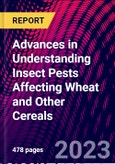Pest Invasions Threaten the Food Security of Millions – What Can We Do?
With growing concerns surrounding the impact of climate change on both native and invasive pest invasions, coupled with the rising threat of global food insecurity, more research is required to understand the major insect pests of cereals, including how best to control and monitor them.
Advances in understanding insect pests affecting wheat and other cereals provides a comprehensive review of the wealth of research that addresses this challenge. This collection discusses the most recent developments in fundamental and applied research on major pests and shows how better understanding of these pests can be used to improve integrated pest management strategies.
Key features
- Addresses the wealth of research on understanding, managing and monitoring major insect pests affecting cereal crops
- Considers emerging issues facing cereal production, including the arrival of invasive species as a result of climate change
- Explores key advances in understanding plant-insect interactions in infestations of wheat and other cereals
What others are saying...
“Wheat provides about 20% of the calories consumed by humans and must continue to do so as the world’s population approaches nine billion in the coming decades. Wheat production faces numerous challenges, not the least of which is damage from insect pests. The editors of Advances in understanding insect pests affecting wheat and other cereals contribute significantly to our ability to mitigate these problems by assembling an outstanding international team of entomologists to update and synthesize knowledge of the biology and sustainable management of the key insect pests of world wheat production.” (Frank B. Peairs, Emeritus Professor of Entomology, Colorado State University, USA)
Editors
Dr Sanford D. Eigenbrode is University Distinguished Professor in the College of Agricultural and Life Sciences at the University of Idaho, USA. A Fellow of the Entomological Society of America, Professor Eigenbrode is internationally known for his research on the chemical ecology of insect-plant interactions, particularly in the context of vector-borne plant pathogens and cropping systems under climate change.
Dr Arash Rashed is Associate Professor in the College of Agriculture and Life Sciences and Director of the Southern Piedmont Agricultural Research and Extension Center, Virginia Tech, USA. He is well known as an expert in the ecology of insect-borne plant pathogens and integrated pest management. He has made significant contributions to our understanding of zebra chip disease ecology and management, as well as managing important subterranean pests such as wireworms in organic and conventional production systems.
Table of Contents
Executive Summary
Wheat continues to be one of the world’s most popular food crops, with around 35% of the global population relying on it as a staple in their daily diets.
“Wheat provides about 20% of the calories consumed by humans,” says Frank B. Peairs, Emeritus Professor of Entomology at Colorado State University, USA.
With the global population expected to exceed nine billion by 2050, this reliance on wheat as a food staple and source of nutrition is only set to grow.
However, with climate change exacerbating the threat of both native and invasive insect pests, more research is required to comprehensively understand the pests responsible for significant yield losses of cereal crops around the world.
Advances in understanding insect pests affecting wheat and other cereals considers the growing concerns surrounding the impact of climate change on pest invasions and the consequent impact on global food security.
“Wheat is arguably the world’s most important crop and climate change is a problem that will not just disappear,” says Francis Dodds, Editorial Director.
“We need to develop and establish more sustainable methods of control which can be used to improve existing integrated pest management programmes. However this can’t be achieved without truly understanding the pests responsible for the damage to wheat yields worldwide,” he concludes.
The book offers a comprehensive outlook on the range of pests affecting wheat and cereal production worldwide, focussing on foliar feeding pests, such as the cereal leaf beetle, gall midges and stem feeding pests, such as the Hessian fly, as well as phloem feeding pests, mites and root feeding pests, such as the Russian wheat aphid and the wheat curl mite.
“Achieving sustainable agriculture and making a positive impact on climate change and the UN Sustainability Goals requires a collaborative approach,” says Rob Burleigh, Managing Director.
“Bringing experts together in this publication creates an unrivalled resource, plus access to leading authorities in entomology provides a great platform to share the latest knowledge,” he adds.
An additional benefit to the book is its consideration of emerging trends and technologies in agriculture, such as biotechnology, remote sensing and artificial intelligence, and their use in the sustainable management of insect pests.








